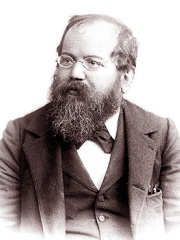
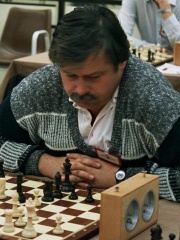
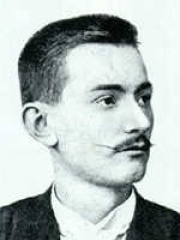
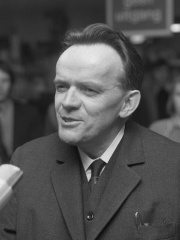
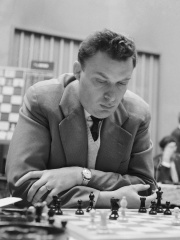
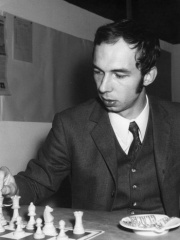
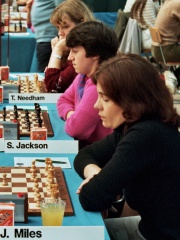
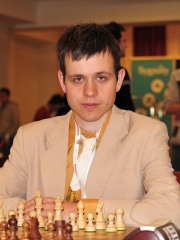
The Most Famous
CHESS PLAYERS from Czechia
This page contains a list of the greatest Czech Chess Players. The pantheon dataset contains 461 Chess Players, 8 of which were born in Czechia. This makes Czechia the birth place of the 15th most number of Chess Players behind Armenia, and India.
Top 9
The following people are considered by Pantheon to be the most legendary Czech Chess Players of all time. This list of famous Czech Chess Players is sorted by HPI (Historical Popularity Index), a metric that aggregates information on a biography’s online popularity.

1. Wilhelm Steinitz (1836 - 1900)
With an HPI of 73.17, Wilhelm Steinitz is the most famous Czech Chess Player. His biography has been translated into 63 different languages on wikipedia.
William Steinitz (born Wilhelm Steinitz; May 14, 1836 – August 12, 1900) was a Bohemian-Austrian and, later, American chess player. From 1886 to 1894, he was the first World Chess Champion. He was also a highly influential writer and chess theoretician. When discussing chess history from the 1850s onwards, commentators have debated whether Steinitz could be effectively considered the champion from an earlier time, perhaps as early as 1866. Steinitz lost his title to Emanuel Lasker in 1894, and lost a rematch in 1896–97. Statistical rating systems give Steinitz a rather low ranking among world champions, mainly because he took several long breaks from competitive play. However, an analysis based on one of these rating systems shows that he was one of the most dominant players in the history of the game. Steinitz was unbeaten in match play for 32 years, from 1862 to 1894. Although Steinitz became "world number one" by winning in the all-out attacking style that was common in the 1860s, he unveiled in 1873 a new positional style of play, and demonstrated that it was superior to the previous style. His new style was controversial and some even branded it as "cowardly", but many of Steinitz's games showed that it could also set up attacks as ferocious as those of the old school. Steinitz was also a prolific writer on chess, and defended his new ideas vigorously. The debate was so bitter and sometimes abusive that it became known as the "Ink War". By the early 1890s, Steinitz's approach was widely accepted, and the next generation of top players acknowledged their debt to him, most notably his successor as world champion, Emanuel Lasker. Traditional accounts of Steinitz's character depict him as ill-tempered and aggressive, but more recent research shows that he had long and friendly relationships with some players and chess organizations. Most notably from 1888 to 1889 he co-operated with the American Chess Congress in a project to define rules governing the conduct of future world championships. Steinitz was unskilled at managing money, and lived in poverty all his life.

2. Vlastimil Hort (b. 1944)
With an HPI of 52.96, Vlastimil Hort is the 2nd most famous Czech Chess Player. His biography has been translated into 22 different languages.
Vlastimil Hort (born 12 January 1944) is a Czechoslovak and later German chess Grandmaster. During the 1960s and 1970s he was one of the world's strongest players and reached the 1977–78 Candidates Tournament for the World Chess Championship, but never qualified for a competition for the actual title. Hort was born in Kladno, Czechoslovakia and was a citizen of Czechoslovakia for the first part of his chess career. He achieved the Grandmaster title in 1965. He won a number of major international tournaments (Hastings 1967–68, Skopje 1969, etc.) and national championships (1970, 1971, 1972, 1975, and 1977). He gained recognition as one of the strongest non-Soviet players in the world, which led to him representing the "World" team in the great "USSR vs. Rest of the World" match of 1970, where he occupied fourth board and had an undefeated +1 score against the Soviet Grandmaster Lev Polugaevsky—in some respects his greatest result. He defected to the West in 1985, moving to West Germany and winning the national championship of his new homeland in 1987, 1989, and 1991.

3. Rudolf Charousek (1873 - 1900)
With an HPI of 51.82, Rudolf Charousek is the 3rd most famous Czech Chess Player. His biography has been translated into 18 different languages.
Rudolf Charousek (Hungarian: Charousek Rezső; 19 September 1873 – 18 April 1900) was a Czech born Hungarian chess player. One of the top ten players in the world during the 1890s, he had a short career, dying at the age of 26 from tuberculosis. Reuben Fine wrote of him "Playing over his early games is like reading Keats's poetry: you cannot help feeling a grievous, oppressive sense of loss, of promise unfulfilled". Charousek was born in Klein Lometz (modern Lomeček) near Prague, Bohemia. At the age of five weeks, his family moved to Debrecen, Hungary, where he became a naturalized Hungarian. They later moved to Miskolc where, at the age of 16, he learned to play chess. Studying law in Kassa, he is said to have copied out the voluminous Handbuch des Schachspiels by hand, unable to afford his own copy. Despite the lack of competition in Kassa, he soon became a strong player, and also qualified as a lawyer. In 1893 he entered a correspondence tournament organised by the Budapest newspaper Pesti Hirlap, in which he eventually shared first place with another up and coming Hungarian master, Géza Maróczy. He joined the Budapest chess club, where he frequently played with Maróczy and Gyula Makovetz, and convincingly defeated Gyozo Exner in a match.

4. Luděk Pachman (1924 - 2003)
With an HPI of 51.07, Luděk Pachman is the 4th most famous Czech Chess Player. Her biography has been translated into 18 different languages.
Luděk Pachman (German: Ludek Pachmann, May 11, 1924 – March 6, 2003) was a Czechoslovak-German chess grandmaster, chess writer, and political activist. In 1972, after being imprisoned and tortured almost to death by the Communist regime in Czechoslovakia, he was allowed to emigrate to West Germany. He lived the remainder of his life there, and resumed his chess career with considerable success, including playing in the Interzonal in 1976 and winning the West German Championship in 1978.
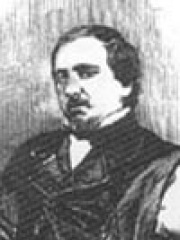
5. Ernst Falkbeer (1819 - 1885)
With an HPI of 48.82, Ernst Falkbeer is the 5th most famous Czech Chess Player. His biography has been translated into 21 different languages.
Ernst Karl Falkbeer (June 27, 1819 – December 14, 1885) was an Austrian chess master and journalist.

6. Miroslav Filip (1928 - 2009)
With an HPI of 47.87, Miroslav Filip is the 6th most famous Czech Chess Player. His biography has been translated into 19 different languages.
Miroslav Filip (27 October 1928 – 27 April 2009) was a Czech chess grandmaster. Filip was awarded the title of International Master in 1953, and the Grandmaster title in 1955. Filip represented Czechoslovakia in 12 consecutive Chess Olympiads from Helsinki 1952 to Nice 1974, playing 194 games with the overall result (+62–28=104).

7. Lubomir Kavalek (1943 - 2021)
With an HPI of 46.33, Lubomir Kavalek is the 7th most famous Czech Chess Player. His biography has been translated into 18 different languages.
Lubomir (Lubosh) Kavalek (Czech: Lubomír Kaválek, August 9, 1943 – January 18, 2021) was a Czech-American chess player. He was awarded both the International Master and International Grandmaster titles by FIDE in 1965. He won two Czechoslovak and three U.S. championships, and was ranked as the world's No. 10 player in 1974. He was inducted into the U.S. Chess Hall of Fame in 2001. Kavalek was also a chess coach, organizer, teacher, commentator, author and award-winning columnist.

8. Jana Bellin (b. 1947)
With an HPI of 40.49, Jana Bellin is the 8th most famous Czech Chess Player. Her biography has been translated into 15 different languages.
Jana Bellin (née Malypetrová; born 9 December 1947) is a British, formerly Czechoslovak chess player. She was awarded the Woman International Master chess title in 1969 and the Woman Grandmaster title in 1982. Bellin was born in Prague, Czechoslovakia. She was the Czech Women's Champion in 1965 and 1967 under her maiden name of Malypetrová. After her marriage to William Hartston she moved to England in 1970 and won the British Women's Championship in 1970, 1971, 1972, 1973, 1974, 1976, 1977 (after a play-off), and 1979. She has fifteen appearances in the Women's Chess Olympiads, representing Czechoslovakia in 1966 and 1969 and England thirteen times from 1972 through 2006, seven times on first board. At the Olympiad she earned individual silver medals in 1966 and 1976, a team bronze medal in 1968 with the Czechoslovakian team, and a team silver in 1976 with England. Bellin is a medical doctor specialising in anaesthetics, and works in intensive care at Sandwell General Hospital, West Bromwich, England. She is also Chairman of the FIDE Medical Commission, which supervises drug testing of chess players. Bellin was married first to International Master William Hartston, then to Grandmaster Tony Miles, and after that to International Master Robert Bellin. She and Bellin have two sons: Robert (born 1989) and Christopher (born 1991). She is the granddaughter of thrice-Prime Minister of Czechoslovakia Jan Malypetr and cousin of author and human rights campaigner Jiří Stránský.

9. David Navara (b. 1985)
With an HPI of 34.33, David Navara is the 9th most famous Czech Chess Player. His biography has been translated into 25 different languages.
David Navara (born 27 March 1985) is a Czech chess grandmaster, the highest-ranked of his country. Awarded the title of Grandmaster by FIDE in 2002, he is a 13-time national champion (in 2004, 2005, 2010, 2012, 2013, 2014, 2015, 2017, 2019, 2020, 2022, 2023 and 2024).
People
Pantheon has 9 people classified as Czech chess players born between 1819 and 1985. Of these 9, 3 (33.33%) of them are still alive today. The most famous living Czech chess players include Vlastimil Hort, Jana Bellin, and David Navara. The most famous deceased Czech chess players include Wilhelm Steinitz, Rudolf Charousek, and Luděk Pachman. As of April 2024, 1 new Czech chess players have been added to Pantheon including Jana Bellin.
Living Czech Chess Players
Go to all RankingsVlastimil Hort
1944 - Present
HPI: 52.96
Jana Bellin
1947 - Present
HPI: 40.49
David Navara
1985 - Present
HPI: 34.33
Deceased Czech Chess Players
Go to all RankingsWilhelm Steinitz
1836 - 1900
HPI: 73.17
Rudolf Charousek
1873 - 1900
HPI: 51.82
Luděk Pachman
1924 - 2003
HPI: 51.07
Ernst Falkbeer
1819 - 1885
HPI: 48.82
Miroslav Filip
1928 - 2009
HPI: 47.87
Lubomir Kavalek
1943 - 2021
HPI: 46.33
Newly Added Czech Chess Players (2024)
Go to all RankingsOverlapping Lives
Which Chess Players were alive at the same time? This visualization shows the lifespans of the 6 most globally memorable Chess Players since 1700.

